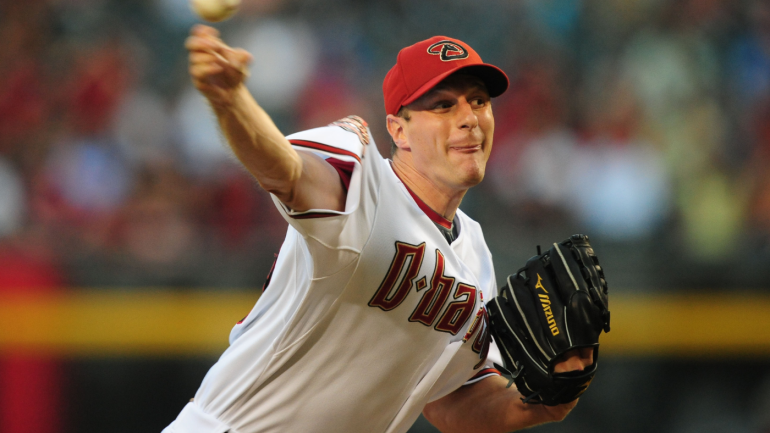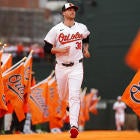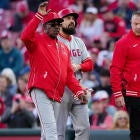
The World Series resumes Monday night with Game 3 between the Texas Rangers and the Arizona Diamondbacks. The best-of-seven series is even at 1-1 following a Diamondbacks blowout victory in Game 2. The teams took Sunday off to travel to Phoenix, where the next three games will be played at Chase Field -- a place that just so happens to hold extra significance for right-hander Max Scherzer, the Rangers' scheduled Game 3 starter.
Although it's easy to forget, Scherzer began his career as a member of the Diamondbacks organization. His first big-league appearance even came at Chase Field in 2008, as part of a relief outing against the Houston Astros. More than 15 years later, Scherzer reflected on his time in the desert ahead of Game 3.
"This is where I debuted and broke into the league and really got to establish. Got to play with some great players at the time. Got to learn from those guys at the beginning of my career," Scherzer said. "It was short. Just basically that year, year and a half. But fortunate for the opportunity that I did get here."
To honor the occasion, and to send readers of a certain age into an existential episode, we here at CBS Sports have highlighted five facts below from Scherzer's Diamondbacks career that you might have lost to a memory hole.
Let's get to it.
1. He wasn't considered a surefire starter
Here's a dirty little secret about prospect analysis: everyone misses, even the professionals. How else do you explain Scherzer slipping to 11th in the 2006 draft? He'd spent three seasons at Missouri, where he had struck out more than a batter per inning and had posted a 2.25 ERA in his junior season. Nevertheless, teams were not sold on Scherzer remaining in the rotation because of the perceived effort in his delivery and his fastball-heavy arsenal.
Kevin Goldstein, who has since worked for the Houston Astros and Minnesota Twins, wrote the following for Baseball Prospectus in January 2008:
The Good: Scherzer is a pure power pitcher with one of the best fastballs around--a low- to mid-90s fastball with outstanding location and a little bit of sink that generates a good ground-ball ratio when contact is made. He'll occasionally flash a plus slider, and he was especially impressive in the Arizona Fall League, when he pitched in short stints and showed even more velocity.
The Bad: Almost all signs point to a future in the bullpen, but he does have closer potential. Scherzer's mechanics are maximum effort, and his secondary pitches lag well behind, with his relatively high walk rate at Double-A blamed on an inability to command his slider.
We share not to criticize Goldstein, but to illustrate that Scherzer was not expected to develop into a Hall of Fame-caliber starter. Keep that in mind as we go through the other facts, since it helps explain some other decisions.
2. Randy Johnson was his teammate
In case you were wondering, Scherzer's time with the Diamondbacks did indeed coincide with Randy Johnson's. The 2008 campaign represented Johnson's final one with the Diamondbacks. (He had returned through a 2007 trade after having previously been shipped to the New York Yankees in 2005.)
Some other notable individuals who appeared on that 2008 Diamondbacks squad include 20-year-old Justin Upton, Adam Dunn, late-career David Eckstein, and future MLB Players Association head Tony Clark. Fellow pitchers alongside Scherzer and the Big Unit included Brandon Webb and Dan Haren. New San Francisco Giants manager Bob Melvin served as Arizona's skipper.
"To be able to learn from and watch these guys go about their business, I'm as lucky as there could be to have that be your teammates when you first break into the league," Scherzer told reporters Sunday. "A lot of it was kind of the little nuances of the game that you kind of take from -- I still remember to this day from Dan and obviously Randy, and how Webby pitched with his sinker/change-up, how that was really effective for him. I actually wish I could go back and circle back with those guys and actually compare notes now."
3. Scherzer's career began out of the bullpen
As noted in the introduction, Scherzer's first career outing came against the Houston Astros on April 29, 2008. He entered in the third inning in relief of Edgar González, who had surrendered six runs to that point in the game.
Scherzer had no such problems with Houston's lineup. He struck out the first batter he faced, opposing pitcher Jack Cassel, by blowing him away with a 96 mph fastball. Scherzer would end up retiring all 13 batters he faced overall, with seven of them going down on strikes.
The Astros, in a sign of things to come, had trouble making good contact against Scherzer's pitches.
4. He opposed Jamie Moyer in first start
Scherzer's next big-league appearance served as his first career start. It came on May 5 at home against the Philadelphia Phillies, the team that would go on to win that year's World Series over the then-upstart Tampa Bay Rays.
Scherzer didn't find the Phillies' lineup to be quite as cooperative as the Astros' had been in his first outing. He lasted four innings, surrendering five runs on eight hits, a pair of walks, and a hit batter. Scherzer did strike out five batters, but he was bested by his Phillies counterpart Jamie Moyer.
Moyer, 45, held the Diamondbacks to two runs over seven innings. He gave up six hits and no walks and he punched out five of his own. For those wondering, Scherzer was born on July 27, 1984. At the time, Moyer was beginning his pro career with the Chicago Cubs' Low-A affiliate in Geneva, New York.
5. His time in Arizona ended in an ill-fated trade
Scherzer proved to not be long for the Diamondbacks. He would end up making 46 total appearances with Arizona, including 37 starts, and posting a 3.86 ERA before the Diamondbacks sent him packing as part of a three-team trade in December 2009. For clarity's sake, here is the full outlay of that deal:
- Diamondbacks receive: RHP Ian Kennedy, RHP Edwin Jackson.
- Tigers receive: RHP Max Scherzer, OF Austin Jackson, LHP Daniel Schlereth, LHP Phil Coke.
- Yankees receive: OF Curtis Granderson.
Kennedy had a few quality seasons with the Diamondbacks, and Jackson recorded the franchise's second no-hitter during his half-year in town. Still, it's fair to write that with the benefit of hindsight, the Diamondbacks would have been better off keeping Scherzer and letting him do his thing.
Scherzer would spend the next five seasons of his career with the Tigers, winning one Cy Young Award and recording a different top-five finish. He would eventually move on to join the Washington Nationals, with whom he would win his first World Series in 2019. Now, he'll take the mound where everything started for him in an attempt to fetch a second ring.






















